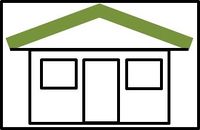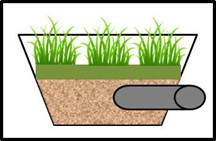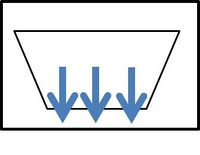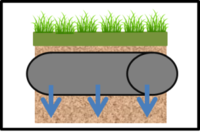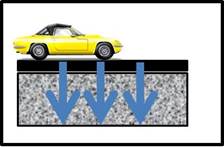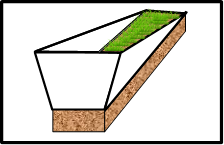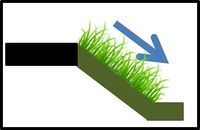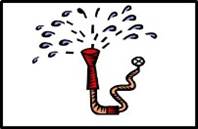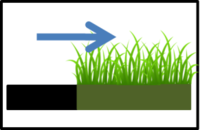
MIDS calculator tips and information for maximizing volume retention
This page provides information and recommendations for maximizing volume retention in the MIDS calculator.
Contents
- 1 Green roof
- 2 Bioretention without underdrain (bioinfiltration)
- 3 Bioretention with underdrain (Biofiltration)
- 4 Infiltration basin/infiltration trench
- 5 Underground infiltration
- 6 Permeable pavement
- 7 Tree trench system/box without underdrain
- 8 Tree trench system/box with underdrain
- 9 Swales
- 10 Harvest and reuse/cistern
- 11 Stormwater disconnection
- 12 Wet swale, sand filter, constructed wetland, and constructed pond
- 13 Summary table
Green roof
- Applicability
- Can have a conventional roof draining to a green roof, but the conventional roof area must be less than or equal to the green roof area.
- If the entire area is green roof (no conventional roof), then it is relatively easy to meet the volume retention requirement
- The media depth is restricted to 4 inches (extensive roofs). If you have an intensive roof (media depth greater than 4 inches), you can simulate an intensive roof by routing one green roof to another. Make sure the surface area matches on the two roofs and the combined media depth for the two roofs equals the media depth for the intensive roof.
- Volume retention
- Maximize media depth to increase retention
- Limit the amount of conventional roof being routed to a green roof to maximize volume retention
Bioretention without underdrain (bioinfiltration)
- Applicability
- Limited to 1.5 foot ponding depth
- The 1.5 foot depth restriction limits infiltration on highly permeable soils
- Diverse BMP that can be incorporated into many landscapes; provides multiple benefits (e.g. habitat, aesthetics)
- Not effective in highly urban and ultra-urban environments because of required space
- Volume retention
- Typically, you will want to maximize depth and limit surface area unless you are designing for other benefits, such as habitat
Bioretention with underdrain (Biofiltration)
- Applicability
- Limited to 1.5 foot ponding depth
- Diverse BMP that can be incorporated into many landscapes; provides multiple benefits (e.g. habitat, aesthetics)
- Not effective in highly urban and ultra-urban environments because of required space
- Volume retention
- Typically, you will want to maximize depth and limit surface area unless you are designing for other benefits, such as habitat
- Raise the underdrain to the extent possible to maximize infiltration
- Maximize evapotranspiration by placing a tree into the BMP
- Phosphorus
- Use Mix C or D to maximize phosphorus removal. Mixes A and B require testing and will likely fail the test.
- Incorporate iron into the system
Infiltration basin/infiltration trench
- Applicability
- More effective than bioinfiltration because depth is only limited by drawdown time requirement
- Not as effective as underground systems in highly urban and ultra-urban environments
- May have limited ability to remove pollutants on highly permeable (A) soils
- Volume retention
- Typically, you will want to maximize depth and limit surface area unless you are designing for other benefits, such as habitat
Link to infiltration basin/trench
Underground infiltration
- Applicability
- A very effective BMP on highly permeable (A) soils. Less effective on B soils due to cost of construction and maintenance.
- Effective in highly urban and ultra-urban environments
- Can be difficult to make calculations and use the calculator to size the practice since calculations are made outside the calculator, unless you have specifications from the manufacturer
- Volume retention
- Typically, you will want to maximize depth and limit surface area unless you are designing for other benefits, such as habitat
Link to infiltration basin/trench
Permeable pavement
- Applicability
- Very effective at reducing volume
- Effective in highly urban and ultra-urban environments
- Limited to 5:1 ratio for impervious:permeable pavement area (Note: permeable pavement is included in impermeable acreage in the calculator)
- Should not route pervious runoff to permeable pavement and should limit impervious:pavement ratio to 2:1 due to maintenance needs
- Generally cannot be used in high traffic areas or with heavy loads
- Volume retention
- Typically will want to maximize surface area versus making the BMP deeper since the BMP is typically able to meet volume retention requirements
- To increase volume retained, unless required, do not compact subsoil
Tree trench system/box without underdrain
- Applicability
- This is a good BMP in highly urban and ultra-urban environments
- Water is stored in the media instead of being ponded. Thus, the amount of water stored is less than bioinfiltration or infiltration basin per unit volume because solids are taking up some of the available storage space
- Diverse BMP that can be incorporated into many landscapes; provides multiple benefits (e.g. habitat, aesthetics)
- Volume retention
- This is typically an underground BMP, so the system could be designed to maximize volume retention by maximizing either area or depth
- Volume retention increase with tree size ( evapotranspiration), but make sure the tree size is practical for the site
- Determine the soil volume needed to maximize tree growth. This can be done by entering the number of trees in the appropriate cell in the calculator and examining the cells displaying volume reduction for ET and the soil volume per tree. Enter the tree number that maximizes ET while maximizing soil volume per tree.
- Coniferous trees increase ET and canopy interception (Note: they must be suitable for the site)
Link to information on tree trenches
Tree trench system/box with underdrain
- Applicability
- This is a good BMP in highly urban and ultra-urban environments
- Water is stored in the media instead of being ponded. Thus, the amount of water stored is less than bioinfiltration or infiltration basin per unit volume because solids are taking up some of the available storage space
- Diverse BMP that can be incorporated into many landscapes; provides multiple benefits (e.g. habitat, aesthetics)
- Volume retention
- This is typically an underground BMP, so the system could be designed to maximize volume retention by maximizing either area or depth
- Volume retention increase with tree size ( evapotranspiration), but make sure the tree size is practical for the site
- Determine the soil volume needed to maximize tree growth. This can be done by entering the number of trees in the appropriate cell in the calculator and examining the cells displaying volume reduction for ET and the soil volume per tree. Enter the tree number that maximizes ET while maximizing soil volume per tree.
- Coniferous trees increase ET and canopy interception (Note: they must be suitable for the site)
- Phosphorus
- Use Mix C or D to maximize phosphorus removal. Mixes A and B require testing and will likely fail the test.
- Incorporate iron into the system
Link to information on tree trenches
Swales
- Applicability
- Swale side slope and swale main channel (with or without underdrain) act as a single BMP. Make sure impervious and pervious acres are applied to the side slope and not the main channel, unless water is routed directly to a main channel. Swale lengths for side slopes and main channel should be the same for a swale system
- Diverse BMP that can be incorporated into many landscapes; provides multiple benefits (e.g. habitat, aesthetics)
- Not a good volume retention practice unless on A soils and/or designed with check dams or bioretention base
- Not good for highly urban and ultra-urban environments
- Volume retention
- Increase swale length to maximize volume retention
- Check dams are the most effective way of capturing and infiltrating water on permeable soils
- Adding a bioretention base increase infiltration if underlying soils are permeable
- Increasing the channel slope reduces infiltration
Harvest and reuse/cistern
- Applicability
- It is difficult to meet the retention requirement with this BMP
- Useful on low permeability soils for reducing the volume delivered to downstream BMPs
- Can be used in highly urban and ultra-urban environments where there are small green spaces to irrigate
- Most effective when there are large green spaces that can be irrigated
- Volume retention
- If there is sufficient space on the site, ponds allow for greater volume storage. Volume reductions with cisterns are typically limited by the storage capacity of the cistern.
- To maximize volume reduction, maximize the volume application area
- On A soils you can apply up to 2 inches per week. This will exceed plant demand but because of the highly permeable soils, excess water will infiltrate. On other soils, to maximize volume reduction, choose “No” for the question asking about a user-defined irrigation rate.
- For vegetation, volume retention follows this order: Trees > turf = vegetables > forage > cereals
- Retaining water on-site typically has a small effect on volume retention
Link to information on stormwater harvest and reuse
Stormwater disconnection
- Applicability
- Cannot be used to meet the Construction Stormwater permit volume retention requirement
- It is difficult to meet the retention requirement with this BMP
- Useful on low permeability soils for reducing the volume delivered to downstream BMPs
- Limited by the area that can effectively infiltrate water (see diagram on BMP Parameters tab for this BMP in the calculator)
- Volume retention
- Maximize the impervious area delivering water to the practice
- Maximize the pervious area (NOTE: this cannot exceed the pervious acres entered in the Watershed tab for this BMP)
Link to information on stormwater impervious disconnection
Wet swale, sand filter, constructed wetland, and constructed pond
These BMPs do not reduce volume
Summary table
The following table provides some summary information for BMPs in the MIDS calculator. Several cells show a range of values. These are explained below.
- Bioretention without underdrain, because of the depth limitation, has moderate retention capacity on A soils compared to other infiltration practices which can be built deeper to infiltrate more water
- Swale main channel has low infiltration capacity on low permeability soils, but high capacity on A soils when check dams are used
- Tree trench without underdrain is an effective infiltration practice but design may be limited by media requirements. High volume retention capacity may require extensive media, which could be cost-prohibitive.
- Tree trench with underdrain may be limited by media requirements. Moderate volume retention capacity may require extensive media, which could be cost-prohibitive.
| BMP | Volume reduction capacity (total) | Volume reduction capacity (per unit BMP area) | Ultra-urban applicability | Multiple benefit applicability |
|---|---|---|---|---|
| Green roof | Low | High | Yes | Yes |
| Bioretention w/o underdrain | Moderate | Moderate-high | No | Yes |
| Bioretention w/underdrain | Low | Low | No | Yes |
| Infiltration basin/trench | High | High | No | Limited |
| Underground infiltration | High | High | Yes | Limited |
| Permeable pavement | Low | High | Yes | Limited |
| Tree trench w/o underdrain | Moderate-high | High | Yes | Yes |
| Tree trench w/underdrain | Low-moderate | Low | Yes | Yes |
| Swale main channel | Low-high | Low-high | No | Yes |
| Swale main channel w/ underdrain | Low | Low | No | Yes |
| Harvest and reuse/cistern | Moderate | Moderate | Yes | Limited |
| Stormwater disconnection | Moderate | Moderate | No | Limited |
